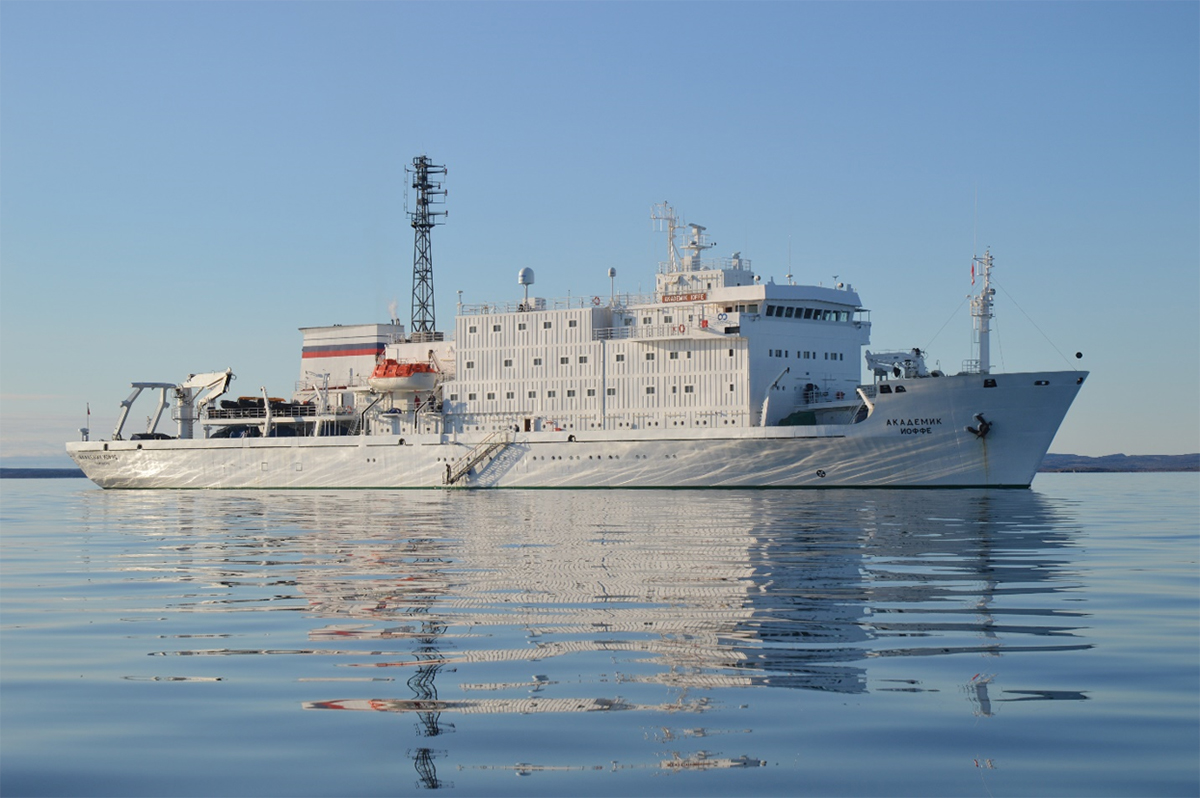Grounding
Passenger vessel Akademik Ioffe
Latitude 69°43.043′ N
Longitude 091°20.951′ W
Astronomical Society Islands, Nunavut
The occurrence
On , the passenger vessel Akademik Ioffe ran aground 78 nautical miles north-northwest of Kugaaruk, Nunavut. The Akademik Ioffe was sailing through narrows in a remote area of the Canadian Arctic that was not surveyed to modern or adequate hydrographic standards, and where none of the vessel crew had ever been. The vessel ran aground at a speed of 7.6 knots before the bridge team could take evasive action; team members were not closely monitoring the echo sounders, and the steady decrease of the under-keel water depth went unnoticed for more than 4 minutes, because the echo sounders’ low water depth alarms had been turned off.
In his assessment of the occurrence voyage plan, the master relied on a Canadian chart that contained incomplete bathymetric data.Footnote 1 Because the chart indicated spot soundings that showed localized sufficient water depths, and because the chart did not show any shoals or other navigational hazards, the bridge team of the Akademik Ioffe considered that the narrows were safe to transit, and consequently did not implement any additional precautions. Following the grounding, the Canadian Coast Guard vessels Pierre Radisson and Amundsen were tasked to assist, and 5 aircraft were dispatched by the Canadian Armed Forces. The vessel self-refloated later that night and, on 25 August 2018, its passengers were evacuated and transferred to the sister passenger vessel Akademik Sergey Vavilov. The Akademik Ioffe sustained serious damage to its hull: 2 ballast water tanks and 2 fuel oil bunker tanks were breached and took on water. An estimated 80.51 L of the vessel's fuel oil was released in the environment. No injuries were reported.
The investigation determined that if a vessel’s crew conducts passage planning and assessment based on incomplete and unreliable navigational data, and without taking mitigating measures, there is an increased risk to the safety of the vessel and its complement. Also, if bridge navigation equipment is not optimally operated and automatic safety features such as alarms are turned off, there is a risk that a bridge team will miss critical information, especially in situations where the prevailing navigating conditions create a high workload for bridge team members. Moreover, if the bridge team composition is inadequate during periods of high workload, such as when transiting confined waters, there is a risk that critical navigational parameters, such as the under-keel water depth, will not be properly monitored, compromising vessel safety.
The TSB investigation into this occurrence revealed safety deficiencies that led the Board to issue a safety recommendation.
Risk mitigation measures for vessels transiting Canadian Arctic waters
Transport Canada regulates navigation of domestic and foreign vessels within Canada’s territorial waters, including the coastal waters surrounding the Canadian Arctic Archipelago. Fisheries and Oceans Canada, through the Canadian Hydrographic Service, is responsible for meeting Canada’s international obligation to provide hydrographic services; the Canadian Coast Guard is responsible for the provision of marine search and rescue resources, traffic monitoring, icebreaker assistance and diffusion of navigation safety information, among other services. Both Transport Canada and the Fisheries and Oceans Canada, combined, have the regulatory mandate to implement various risk mitigation measures to reduce the likelihood and consequences of a passenger vessel running aground in Arctic waters.
This investigation determined that voyage planning in the Canadian Arctic has unique risks that require additional mitigation measures in order to ensure the safety of passenger vessels, and to protect the vulnerable Arctic environment. Until the coastal waters surrounding the Canadian Arctic Archipelago are surveyed to modern or adequate hydrographic standards, and if alternate mitigation measures are not put in place, there is a persistent risk that vessels will make unforeseen contact with the sea bottom. The Board therefore recommends that
the Department of Transport, in collaboration with the Department of Fisheries and Oceans, develops and implements mandatory risk mitigation measures for all passenger vessels operating in Canadian Arctic coastal waters.
TSB Recommendation M21-01
Media materials
News release
TSB calls for mandatory risk mitigation measures for passenger vessels operating in Canadian Arctic
Read the news release
Backgrounders
Deployment notice
TSB deploys a team of investigators to Kugaaruk, Nunavut, following the grounding of the passenger vessel Akademik IoffeQuébec, Quebec, 27 August 2018 — The Transportation Safety Board of Canada (TSB) is deploying a team of investigators to Kugaaruk, Nunavut, following the 24 August 2018 grounding of the passenger vessel Akademik Ioffe. The TSB will gather information and assess the occurrence.
Investigation information
Download high-resolution photos from the TSB Flickr page.
Class of investigation
This is a class 2 investigation. These investigations are complex and involve several safety issues requiring in-depth analysis. Class 2 investigations, which frequently result in recommendations, are generally completed within 600 days. For more information, see the Policy on Occurrence Classification.
TSB investigation process
There are 3 phases to a TSB investigation
- Field phase: a team of investigators examines the occurrence site and wreckage, interviews witnesses and collects pertinent information.
- Examination and analysis phase: the TSB reviews pertinent records, tests components of the wreckage in the lab, determines the sequence of events and identifies safety deficiencies. When safety deficiencies are suspected or confirmed, the TSB advises the appropriate authority without waiting until publication of the final report.
- Report phase: a confidential draft report is approved by the Board and sent to persons and corporations who are directly concerned by the report. They then have the opportunity to dispute or correct information they believe to be incorrect. The Board considers all representations before approving the final report, which is subsequently released to the public.
For more information, see our Investigation process page.
The TSB is an independent agency that investigates air, marine, pipeline, and rail transportation occurrences. Its sole aim is the advancement of transportation safety. It is not the function of the Board to assign fault or determine civil or criminal liability.
